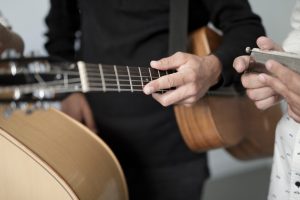Here’s a “quick guide” in how to play gypsy jazz guitar…..but have patience…as the say: “the first 10 years is the hardest!!”
In the old days you had to travel around the world to Gypsy Jazz Festivals to get a chance to see the great masters play. Today it’s all on Youtube, one click away. Youtube is a really great platform for guitar players, but the best way to learn Djangos style is still to participate in as many Gypsy Jazz-jam sessions as possible. Here you will experience the energy in the music and hopefully find inspiration and get the music under your skin. If you don’t get inspired by seeing great musicians play in real life, you may soon loose interest in this difficult guitar style – because it takes a long time to become a good player. You can find Gypsy Jazz-jam sessions in most of the big city’s all over the world or the many Gypsy Jazz Festivals.
If you want to do some homework first, here’s some different things you can start with:
- Gypsy Jazz Schools: Check out some of the best Gypsy Jazz online guitarschools like Robins Gypsyjazzsecrets. Robin is dedicated to the Gypsy Jazz style and to the “gypsyjazz school”. He is a pioneer in teaching this style and his vidoes and books has been used in many years. At the homepage Rosenberg Academy you can also get video lessons in the “Dutch Style” by Stocholo Rosenberg. A lot of these videos are also on Youtube and it’s possible to slow the video down to 50% or 25% in speed, without losing the key – a great thing if it is going too fast. If you are more into the modern “French style” you can visit Dennis Changs Music School. He’s made a lot of videos and transcriptions of some of the great players like Bireli Lagrene and Selmer #607. He also feature some of the great rhythm-guitarplayers.
- Sheet music: Get hold of the “Django Fakebook” as PDF on the internet. Here you will find the basic melodies and standards that are most commonly used in Gypsy Jazz jam-sessions. In contains around 200 tunes and many of them are Django’s most famous melodies. Remember to sing the melody when you are rehearsing the chords, so you don’t get lost when you are practicing or playing.
- Backing tracks: Learn a variety of the different Gypsy Jazz rhythms like swing, waltz, gypsy bossa, bolero and practice with a metronome if needed. It’s a good idea to record your own rhythm tracks – then you can use them later for practicing your solo playing. You can also find many youtube playlists containing gypsy jazz backing tracks.
- The left hand: Django only used two fingers in his solo-note playing and he had his own fingering system built around the 2 fingers on his left hand that had full mobility. His solos contained lots of arpeggios that could be played with 2 notes per string patterns which ran horizontally up and down the fretboard. This gave him his famous great speed and fluidity. You can read more about his freet hand at this great Gypsy Jazz UK website. You can also see Django’s left and right hand technic in action in the famous “Hot Jazz” video or check out Antonis Arfanis who has made several videos where he plays Django’s famous solos with two fingers. Most gypsy jazz-players today also use their 3rd and 4th fingers when playing solos since it’s very hard to make the large stretch between your index and middle fingers like Django did. It’s not so important which fingers you use – is more important on which strings you play the phrase and that you have a good coordination with you right hand.
- The right hand: When you’re ready for the solo and the melody part, then you can check out the Gypsy Jazz picking style called “downstroke technique” or “reststroke technique”. It’s used by many of the great guitarplayers because it gives a clear sound and good tone on the Selmer guitars. Many of the players combine this technique with alternate picking to get a more modern sound. At the homepage DjangoBooks.com you can find the book “Gypsy Picking” by Michael Horowitz and a lot of other great books on Gypsy Jazz. On Youtube there’s several videos with guitarists explaining how the technique works like these three tutorials: 1) https://youtu.be/DLuYexyPh30 2) https://youtu.be/uzfeEHOqWI0 3) https://youtu.be/PzNxcxUp1Z0.
- Practicing solos: Now you are ready for practicing scales, arpeggios, licks and to speed up your technique – because sometimes you play a lot of notes in Gypsy Jazz even though the melody always is the most important thing!! Remember to start slowly and increase the speed only when every tone is 100% clear. For inspiration on how to do that take a look at Yaakov Hoter’s video on how to increase your practicing and technique at GypsyAndJazz.com.
Have fun and see you to our concerts and the jam sessions!
all the best
Robert & Jens – guitarplayers in Rêve Bohème



